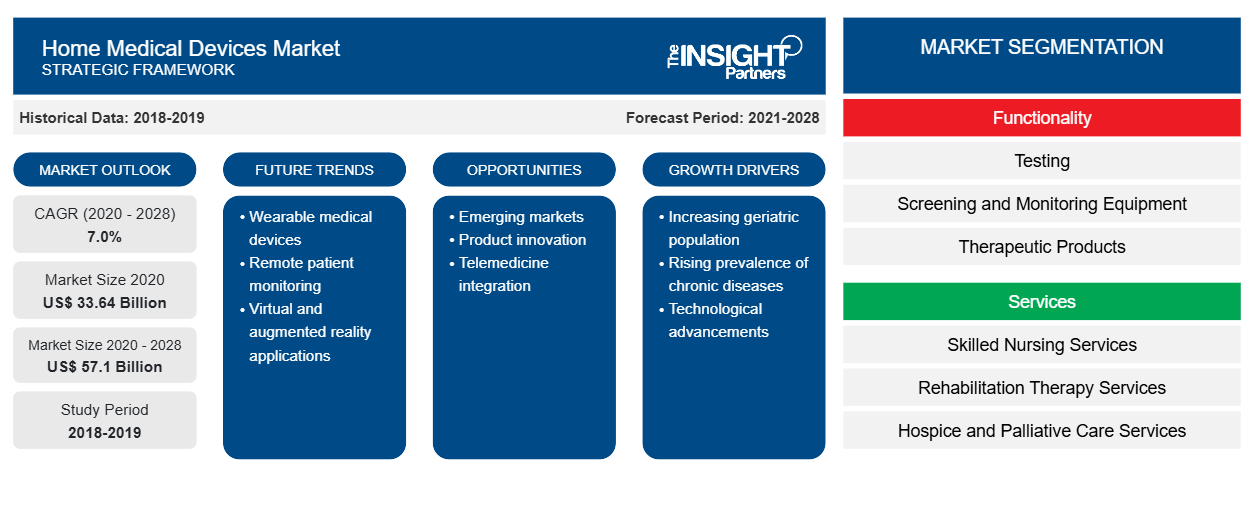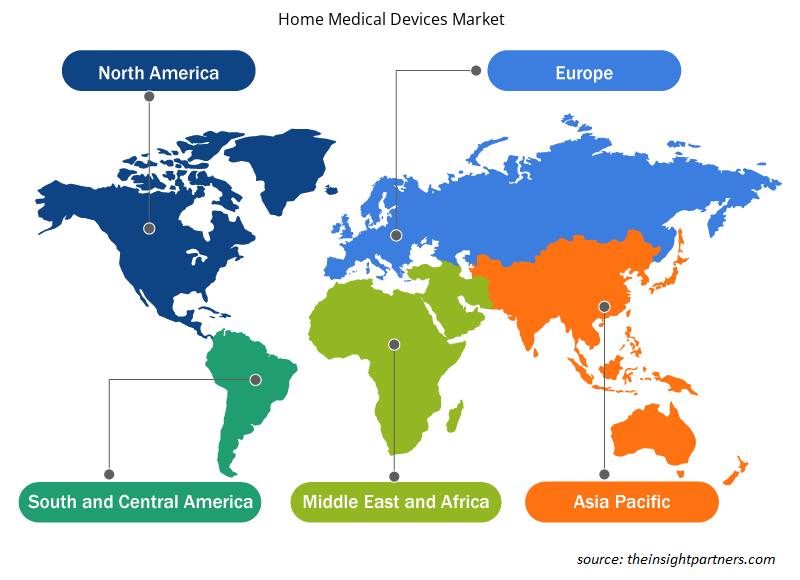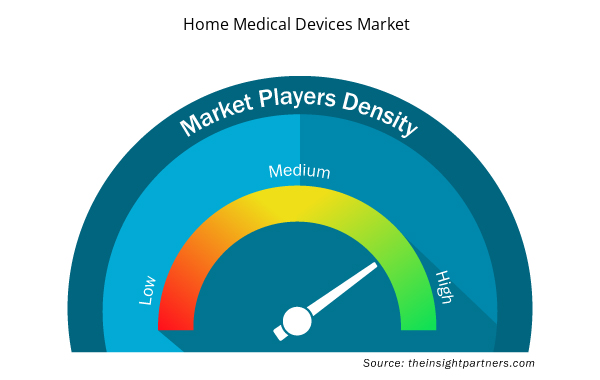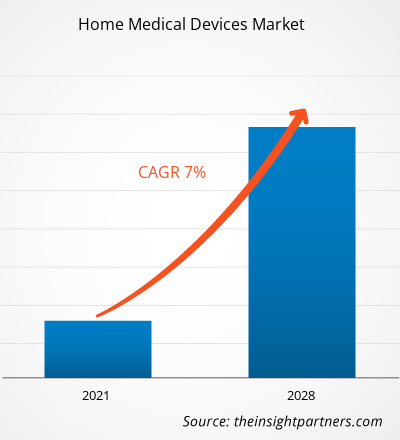The home medical devices market is projected to reach US$ 57,102.9 million by 2028 from US$ 33,635.2 million in 2020; it is estimated to grow at a CAGR of 7.0% from 2021 to 2028.
A home medical device is intended for patients (care recipients) in any environment. This includes devices intended for use in both professional healthcare facilities and homes. A home medical device may include a glucose meter, heating pad, hospital bed, walker, ventilator, wheelchair, and others.
The home medical devices market is segmented based on functionality, services, distribution channel, and geography. The market, by geography, is broadly segmented into North America, Europe, Asia Pacific, Middle East & Africa, and South & Central America. The market report offers insights and in-depth analysis of the market, emphasizing parameters such as market size, market trends, technological advancements in the market, and market dynamics, along with the global analysis of the competitive landscape of the leading market players that are driving the market growth.
The home medical devices market growth is attributed to the growing demand for homecare medical devices by the geriatric population, increasing homecare settings, and rising market consolidation, which has significantly increased the market size and is expected to have a significant short-, mid-, and long-term impact on the market size. However, stringent regulations, challenges, and risks for homecare medical devices are expected to hamper the growth of the market. The home medical devices market report also studies the ongoing opportunities and market trends that can have a possible impact on the market growth.
Customize This Report To Suit Your Requirement
You will get customization on any report - free of charge - including parts of this report, or country-level analysis, Excel Data pack, as well as avail great offers and discounts for start-ups & universities
Home Medical Devices Market: Strategic Insights

- Get Top Key Market Trends of this report.This FREE sample will include data analysis, ranging from market trends to estimates and forecasts.
You will get customization on any report - free of charge - including parts of this report, or country-level analysis, Excel Data pack, as well as avail great offers and discounts for start-ups & universities
Home Medical Devices Market: Strategic Insights

- Get Top Key Market Trends of this report.This FREE sample will include data analysis, ranging from market trends to estimates and forecasts.
Market Insights
Growing Demand for Homecare Medical Devices due to Increasing Geriatric Population
The home medical devices market is estimated to grow significantly due to primary factors such as increasing development in the medical device industry and growing geriatric population. Owing to the increasing technological development, remote patient monitoring has evolved as an excellent growth strategy for medical device players. The growing geriatric population has supported the market players by demanding user-friendly, efficient, accurate, and effective medical devices in a homecare setting. Therefore, the demand for monitoring devices, mobility aids devices, and therapeutic devices among older people has significantly increased and helped in leveraging the market's growth.
Similarly, technological developments have enabled players to integrate the internet of things (IoT) with medical devices, which facilitates the connection between patients and service providers. The built-in connectivity for medical devices through mobile applications, cloud, machine-to-machine, and other options has resulted in the adoption of telemedicine and mHealth technologies. Thus, the developments have allowed medical device players to attract the geriatric population segment to offer their innovative home medical devices. It is expected that the growing population will broadly contribute to the indirect growth of the market as the countries across the world are experiencing growth in the geriatric population. Hence, the demand for home medical devices will exponentially grow in coming future. For instance, countries such as the US, Japan, South Korea, Canada, the UK, Spain, and France are significantly experiencing growth in the geriatric population.
The above-mentioned countries along with China, India, Saudi Arabia, the UAE, and Brazil offer significant growth opportunities for the medical device players to provide innovative devices. The improved healthcare services such as diagnostics and therapeutics have helped in declining death rates. On the other hand, the improving healthcare system is widely contributing to the growth of the geriatric population. According to the United Nations (UN) estimation, by 2060, there will 1.8 billion older people, which will account for 17.8% of the world's total population. Population growth will see the rise twice of 607 million people, i.e., 8.2% of the world's total population in 2015. Therefore, as per the estimation, the growth of the home medical devices market is expected to be driven by the increasing geriatric population during the forecast period.
Functionality-Based Insights
The global home medical devices market, based on functionality, is segmented into testing, screening & monitoring equipment, therapeutic products, mobility care products, biofeedback instruments, electrical stimulation devices, and muscle stimulators. The testing, screening and monitoring equipment segment held the largest share of the market in 2020 and is anticipated to register the highest CAGR during the forecast period. The testing, screening & monitoring equipment segment is further segmented into blood glucose monitors, heart rate monitors, sleep apnea monitors, hearing aids, temperature monitors, fetal monitoring devices, cholesterol monitoring devices, ECG/EKG devices, drug & alcohol test kits, coagulation monitors, blood pressure monitors, EEG devices, pulse oximeters, home hemoglobin A1c test kits, colon cancer test kits, ovulation & pregnancy test kits, HIV test kits, pedometers, peak flow meters, and Holter & event monitors. The therapeutic products segment is further segmented into oxygen delivery systems, ventilators, dialysis equipment, sleep apnea therapeutic devices, would care products, IV equipment, nebulizers, insulin delivery devices, inhalers, and other therapeutic products. The mobility care products of the home medical devices market are further segmented into canes, crutches, mobility scooters, walkers & rollators, and wheelchairs.
Services-Based Insights
Based on the services, the home medical devices market is segmented into skilled nursing services, rehabilitation therapy services, hospice and palliative care services, respiratory therapy services, infusion therapy services, pregnancy care services, and unskilled care services. In 2020, the skilled nursing services segment held the largest share of the home medical devices market and is expected to grow at the fastest rate during the coming years.
Home Medical Devices Market Regional Insights
The regional trends and factors influencing the Home Medical Devices Market throughout the forecast period have been thoroughly explained by the analysts at Insight Partners. This section also discusses Home Medical Devices Market segments and geography across North America, Europe, Asia Pacific, Middle East and Africa, and South and Central America.

- Get the Regional Specific Data for Home Medical Devices Market
Home Medical Devices Market Report Scope
| Report Attribute | Details |
|---|---|
| Market size in 2020 | US$ 33.64 Billion |
| Market Size by 2028 | US$ 57.1 Billion |
| Global CAGR (2020 - 2028) | 7.0% |
| Historical Data | 2018-2019 |
| Forecast period | 2021-2028 |
| Segments Covered |
By Functionality
|
| Regions and Countries Covered | North America
|
| Market leaders and key company profiles |
Home Medical Devices Market Players Density: Understanding Its Impact on Business Dynamics
The Home Medical Devices Market is growing rapidly, driven by increasing end-user demand due to factors such as evolving consumer preferences, technological advancements, and greater awareness of the product's benefits. As demand rises, businesses are expanding their offerings, innovating to meet consumer needs, and capitalizing on emerging trends, which further fuels market growth.
Market players density refers to the distribution of firms or companies operating within a particular market or industry. It indicates how many competitors (market players) are present in a given market space relative to its size or total market value.
Major Companies operating in the Home Medical Devices Market are:
- F. Hoffmann-la Roche Ltd.
- General Electric Company
- Abbott
- Koninklijke Philips N.V.
- B. Braun Melsungen AG
Disclaimer: The companies listed above are not ranked in any particular order.

- Get the Home Medical Devices Market top key players overview
Distribution Channel-Based Insights
Based on the distribution channel, the global home medical devices market is segmented into hospital pharmacies, retail pharmacies, and online retailers. The hospital pharmacy segment held the largest share of the market in 2020 and is estimated to register the highest CAGR in the market during the forecast period.
Product launches and approvals are the commonly adopted strategies by companies to expand their global footprints and product portfolios in the home medical devices market. Collaboration is one of the major strategies adopted by the home medical devices market players to enlarge customer base worldwide, which, in turn, permits them to maintain their brand name globally.
- Historical Analysis (2 Years), Base Year, Forecast (7 Years) with CAGR
- PEST and SWOT Analysis
- Market Size Value / Volume - Global, Regional, Country
- Industry and Competitive Landscape
- Excel Dataset



Report Coverage
Revenue forecast, Company Analysis, Industry landscape, Growth factors, and Trends

Segment Covered
Functionality, Services, and Distribution Channel

Regional Scope
North America, Europe, Asia Pacific, Middle East & Africa, South & Central America

Country Scope
Argentina, Australia, Brazil, Canada, China, France, Germany, India, Italy, Japan, Mexico, Saudi Arabia, South Africa, South Korea, Spain, United Arab Emirates, United Kingdom, United States
Frequently Asked Questions
Who are the major players in the home medical devices market?
The home medical devices market majorly consists of the players such as F. Hoffmann-La Roche Ltd., General Electric Company, Abbott, Koninklijke Philips N.V., B. Braun Melsungen AG, Johnson and Johnson Services, Inc., Medtronic, Medline Industries, Inc., Baxter International Inc., and Invacare Corporation. among others.
What are the driving factors for the home medical devices market across the globe?
The global home medical devices market growth is mainly attributed to factors such growing demand for homecare medical devices due to increasing geriatric population, increasing homecare settings, and rising market consolidation. However, stringent regulations, challenges, and risks for homecare medical devices are key factors restraining the market growth.
What are home medical devices?
A home use medical device or home medical device is intended for patients (care recipient) in any environment. This includes devices intended for use in both professional healthcare facilities and homes. Additionally, changes in healthcare have encouraged care from the hospital environment to the home environment. Home medical device may include glucose meter, heating pad, hospital bed, walker, ventilator, wheelchair and others.
Trends and growth analysis reports related to Life Sciences : READ MORE..
The List of Companies - Home Medical Devices Market
- F. Hoffmann-la Roche Ltd.
- General Electric Company
- Abbott
- Koninklijke Philips N.V.
- B. Braun Melsungen AG
- Johnson and Johnson Services, Inc.
- Medtronic
- Medline Industries, Inc.
- Baxter International Inc.
- Invacare Corporation

 Get Free Sample For
Get Free Sample For